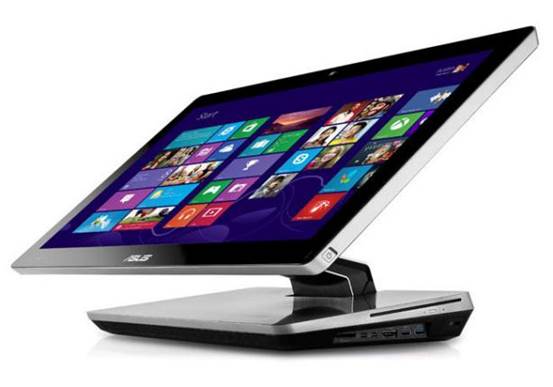The concept of the desktop PC that folds
flat Like a tabletop is catching on. HP was first, with its 21 workstation, but
Lenovo brought the technology to consumer all in ones with its very sexy
IdeaCentre A720. Now Asus has adopted the idea for its new ET2300 series.
Like the A720, the E2300 tucks all its
components inside the base of its display; but for whatever reason, Asus needed
more room than Lenovo. The E2300s base is thin enough at the front, but it
slopes up to about 1.5 inches high in the back. Lenovo’sA720 is less than an
inch thick all around.

Lenovo’sA720
is less than an inch thick all around.
Asus makes very big claims for the ET2300’s
audio performance, as in the best audio experience ever in an AiO. Uh, no. Asus
did go farther on this score than most manufacturers have the ET2300 has a
four-speaker array augmented by an internal subwoofer, and you can buy an
optional (and proprietary) outboard subwoofer but this all in one sounds only
slightly better than the nails on a chalkboard A720. Plan on using headphones
for a personal audio experience or external powered speakers to fill a room.
This ET2300 model that Asus sent us costs
$400 less than Lenovos A720, but its 23-inch IPS panel is much smaller than the
27-inch VA panel that Lenovo delivers (both models deliver the typical
resolution of 1920x1080, and both provide 10 touch points to support Windows
8.1 Although the Asus has a lesser CPU (the ET2300 ships with a 36Hz Intel Core
i5-3330 desk top processor that doesn’t support Hyper-Threading, compared to
the A720s 2.36Hz Intel Core i7-3610QM mobile that does), the two machines
traded benchmark wins. The Asus proved slightly faster on the gaming-oriented
tests (3DMark 11 and Metro 20331, despite the fact that both machines are
equipped with 8GB of DDR3/1600 memory and discrete graphics in the form of
Nvidias GeForce GT 630M. We surmise it’s because the Asus’s base clock is far
higher. The Lenovo, on the other hand, delivered better performances with our
Adobe Premiere and MainConcept benchmarks, thanks to its Hyper -Threading.

The
Lenovo, on the other hand, delivered better performances with our Adobe
Premiere and MainConcept benchmarks, thanks to its Hyper -Threading.
Aside from the size of its display and with
the exception of its optical drive (Lenovo packs a slot-feed Blu-ray player/DVD
burner in the A720. where Asus provides only a slot-feed OVO burner), the
balance of the Asus’s spec sheet is far superior. Both machines come with 1TB
of storage, but the drive in the ET6300 spins its platters at 7,200rpm compared
to the 5.600rpm model in the A720, and where the A720 is outfitted with two USB
2.0 ports and two USB 3.0 ports, the ET2300 ships with four USB 3.0 ports plus
an eSATA/USB 2.0 combo port and two Thunderbolt ports.
Thunderbolt technology delivers
bidirectional data transfer speeds up to 10Gb/s. and you can daisy-chain up to
six Thunderbolt devices, including a Display-Port monitor. While there are just
a handful of storage devices currently on the market, we expect to see them
proliferate over time. Ditto for Thunderbolt displays.

Like any all-in-one worthy of the name, the
ET2300 has an HDMI input (to support a gaming console or set-top box); but in
addition to providing HDMI out (to support a second display or a video
projector), the ET2300 also supports WiDi, so that it can wirelessly mirror its
audio/video output to a TV or a streaming box (such as Netgear’s new Neo-TV
Maxi that supports that Intel technology.
The ET2300 certainly isn’t a barn burner,
but it is a solid all-around family PC. While we expected to see a Blu-ray
drive at this price point, the presence of Thunderbolt and WiDi are welcome
features.